
Latin American Journal of Content & Language Integrated-LACLIL
Scope & Guideline
Fostering Language Mastery Through Integrated Learning
Introduction
Aims and Scopes
- Content and Language Integration:
The journal emphasizes studies that investigate how content subjects can be taught alongside language learning, promoting bilingualism and multilingualism in educational settings. - Innovative Teaching Methodologies:
LACLIL showcases research on diverse teaching methodologies, including project-based learning, the use of technology in the classroom, and emotional engagement strategies to enhance language acquisition. - Teacher Development and Identity:
There is a consistent focus on the professional development of teachers within CLIL contexts, examining their needs, identities, and the impact of training on teaching effectiveness. - Student Perspectives and Engagement:
The journal highlights research that captures student perspectives, engagement, and experiences in CLIL environments, providing insights into how learners interact with content and language. - Contextual Factors in Education:
LACLIL investigates the influence of contextual factors on the implementation of CLIL, including cultural, institutional, and social dimensions that affect teaching and learning.
Trending and Emerging
- Digital Learning Environments and Technology Integration:
A growing body of research is focusing on the integration of digital tools and virtual learning environments in CLIL, highlighting their role in enhancing language and content learning outcomes. - Critical Thinking and Active Citizenship:
There is an increasing emphasis on incorporating critical thinking and active citizenship into CLIL curricula, promoting higher-order thinking skills and social awareness among students. - Emotional Engagement in Learning:
Research exploring the emotional dimensions of learning within CLIL contexts is gaining traction, emphasizing the importance of emotional well-being and motivation in language acquisition. - Teacher Training and Professional Development:
Emerging themes highlight the need for ongoing teacher training and development in CLIL, focusing on equipping educators with the skills and knowledge to effectively implement CLIL methodologies. - Student-Centered Approaches and Co-Creation:
There is a notable trend towards student-centered pedagogies and the co-creation of learning materials, reflecting a shift towards collaborative and participatory learning environments.
Declining or Waning
- Traditional Language Teaching Methods:
There is a noticeable decrease in research centered around traditional, grammar-focused language teaching methods, as the journal increasingly emphasizes integrated and innovative approaches. - General Language Proficiency Assessments:
The focus on general language proficiency assessments is waning, with fewer studies addressing standardized testing in CLIL contexts, possibly due to a shift towards more holistic assessment practices. - Examining CLIL in Primary Education:
Research specifically targeting CLIL implementation in primary education settings has become less frequent, suggesting a shift towards higher education contexts or more specialized applications. - Focus on Non-CLIL Subjects:
There is a reduced emphasis on studies exploring non-CLIL subjects, indicating a narrowing of focus towards purely CLIL-related topics and methodologies.
Similar Journals

Journal of Science Education and Technology
Shaping Tomorrow’s STEM Leaders Today.The Journal of Science Education and Technology, published by SPRINGER, stands as a premier platform in the fields of education and engineering, recognized with a prestigious Q1 ranking in both categories as of 2023. With an ISSN of 1059-0145 and an E-ISSN of 1573-1839, this journal serves as a pivotal resource for researchers, educators, and practitioners alike, emphasizing the integration of scientific inquiry and technological advancements in educational contexts. Since its inception in 1992, the journal has consistently provided high-quality, peer-reviewed research that shapes contemporary practices and methodologies in science education. With its notable Scopus rankings, including a 95th percentile in Social Sciences Education, the journal is essential for anyone eager to enhance their understanding of effective teaching in STEM fields. While the journal is not open access, its contributions are invaluable to advancing knowledge and innovations that are crucial for the progressive education landscape, making it a must-read for scholars and students committed to excellence in science education.
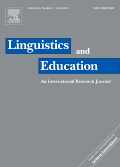
Linguistics and Education
Bridging Language and Learning for Future GenerationsLinguistics and Education, published by Elsevier, is a premier journal dedicated to advancing the understanding of the intersections between linguistics and educational practices. With its ISSN 0898-5898 and E-ISSN 1873-1864, this journal has established itself as a significant platform since its inception in 1988, continuing to produce impactful research up to 2024. It enjoys a prestigious Q1 ranking in both the Education and Linguistics and Language categories, reflecting its high-quality contributions and leading role in the field. The journal’s Scopus rankings further underscore its influence, being placed in the 87th percentile for Arts and Humanities in Language and Linguistics, and the 86th percentile in Social Sciences in Linguistics and Language. Although it operates under traditional subscription access, its contributions are essential for researchers, professionals, and students alike, making substantial strides in the understanding of language, learning environments, and pedagogical strategies. The journal's objective is to foster interdisciplinary dialogue and disseminate innovative research that informs educational policy and practice.
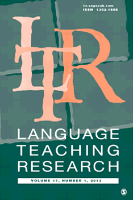
Language Teaching Research
Bridging theory and practice in language teaching.Language Teaching Research, published by SAGE Publications Ltd, serves as a pivotal platform for scholars and practitioners in the domains of education and linguistics. Since its inception in 1997, this prestigious journal has maintained its status within the Q1 category for both Education and Linguistics, symbolizing its significant impact and commitment to excellence in research. With impressive Scopus rankings placing it among the top percentile in its fields, Language Teaching Research provides a comprehensive array of articles, studies, and reviews dedicated to advancing the theory and practice of language education. Although currently not an Open Access journal, it remains essential reading for those engaged in the evolving challenges and methodologies surrounding language teaching and learning. The journal aims to foster insightful discussions and disseminate innovative research findings, making it a crucial resource for educators, researchers, and students keen on enhancing language acquisition and pedagogical strategies.
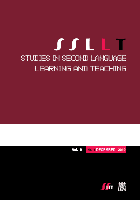
Studies in Second Language Learning and Teaching
Bridging theory and practice in language education.Studies in Second Language Learning and Teaching is a premier open-access journal dedicated to advancing research and scholarship in the fields of education, linguistics, and language acquisition. Published by ADAM MICKIEWICZ UNIVERSITY, KALISZ, this journal has consistently achieved high acclaim, reflected in its impressive Q1 rankings in both Education and Linguistics and Language categories for 2023. With a robust focus on innovative methods, effective pedagogical strategies, and interdisciplinary approaches, Studies in Second Language Learning and Teaching aims to facilitate dialogue among researchers, educators, and practitioners, fostering a deeper understanding of language learning and teaching in diverse contexts. Since its transition to open access in 2011, the journal has expanded its reach, providing valuable resources and research findings to a global audience. With an exceptional Scopus ranking placing it in the top percentiles across multiple categories, this journal stands as a crucial platform for the dissemination of ground-breaking research in second language education.
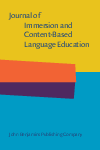
Journal of Immersion and Content-Based Language Education
Fostering Global Dialogue in Immersive Language EducationJournal of Immersion and Content-Based Language Education, published by JOHN BENJAMINS PUBLISHING CO, is a leading academic journal dedicated to the fascinating intersection of language education and immersive learning experiences. With its ISSN 2212-8433 and E-ISSN 2212-8441, the journal has carved a prominent niche in both the Education and Linguistics fields, earning a Q2 ranking in Education and a prestigious Q1 ranking in Linguistics, as noted in 2023. Situated in the Netherlands, this journal caters to a global audience, offering access to cutting-edge research and methodologies in content-based language instruction. Committed to fostering scholarly dialogue, the Journal of Immersion and Content-Based Language Education empowers researchers, educators, and students alike to explore innovative practices and theoretical frameworks. With a Scopus ranking reflecting its impact in the field—#196/1088 in Language and Linguistics at the 82nd percentile and #807/1543 in Education—this journal is a vital resource for those committed to enhancing linguistic education through immersive methodologies.
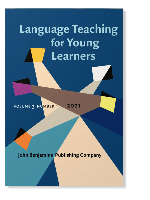
Language Teaching for Young Learners
Innovating pedagogical practices for early language acquisition.Language Teaching for Young Learners, published by John Benjamins Publishing Co, is a premier journal dedicated to enhancing the pedagogy of language acquisition in early childhood education. Since its inception in 2019, it has rapidly established itself within the research community, reflected by its high Scopus rankings—placing it in the 85th percentile for Language and Linguistics and the 84th percentile for Education. The journal aims to provide a platform for innovative research, practical insights, and theoretical discussions surrounding the teaching of languages to young learners, thus contributing significantly to the fields of Education and Linguistics. With an open access model currently unavailable, it caters to a diverse global audience, including researchers, educators, and policy-makers, keen on improving pedagogical practices. Located in the Netherlands, the journal's commitment to academic excellence is evident through its Q1 and Q2 rankings in Linguistics and Language and Education respectively, encouraging continual discourse in cultivating effective language education practices.
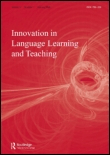
Innovation in Language Learning and Teaching
Advancing Language Education with Groundbreaking Research.Innovation in Language Learning and Teaching is a premier peer-reviewed journal published by Routledge Journals, Taylor & Francis Ltd, focusing on the intersection of innovative practices in language education and teaching methodologies. With a notable impact factor reflected in its recent placement in the Q1 quartile for both Education and Linguistics and Language categories, this journal serves as a crucial resource for scholars and practitioners aiming to enhance pedagogical approaches and improve learning outcomes in language education. Spanning from 2009 to 2024, it showcases cutting-edge research that addresses contemporary challenges in the field, facilitating a deeper understanding of language acquisition, pedagogy, and curriculum development. The journal is indexed in Scopus, demonstrating its significant contribution to the academic community, with impressive ranks in both the Arts and Humanities as well as the Social Sciences categories. Although it follows a traditional subscription model, the journal is committed to disseminating high-quality research that fosters collaboration and discussion among researchers, educators, and students dedicated to advancing language learning and teaching practices.

GIST-Education and Learning Research Journal
Transforming Learning through Rigorous ScholarshipGIST-Education and Learning Research Journal, published by INST UNIV COLOMBO AMERICANA-UNICA, stands as a prominent vessel for the dissemination of scholarly research in the field of education and learning. Since its inception in 2007, this open access journal has championed the free exchange of knowledge, allowing researchers, educators, and students from around the globe to contribute to and benefit from the latest findings and practices in educational theory and methodology. With its commitment to enhancing educational practices and influencing policy through rigorous research, GIST-Education and Learning Research Journal invites submissions that explore innovative teaching strategies, learning technologies, educational psychology, and related fields. Its accessibility and dedication to quality research make it an invaluable resource for anyone invested in the improvement of educational outcomes.
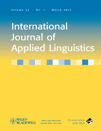
International Journal of Applied Linguistics
Advancing the Frontiers of Language ResearchInternational Journal of Applied Linguistics, published by WILEY, is a premier platform for cutting-edge research in the field of applied linguistics. With a notable Impact Factor and ranked in the top Q1 quartile of linguistics and language, this journal serves as an essential resource for scholars, practitioners, and students. The journal’s wide-ranging scope includes various subfields such as language acquisition, language education, sociolinguistics, and discourse analysis, fostering multidisciplinary approaches to language studies. It has achieved a significant Scopus Rank, placing it in the 90th percentile for both Arts and Humanities as well as Social Sciences categories, reflecting its high visibility and influence in the academic community. The International Journal of Applied Linguistics is committed to advancing the understanding of language use in real-world contexts through rigorously peer-reviewed articles that contribute to both theory and practical applications. While it is not an open-access journal, it remains a highly respected publication for researchers looking to disseminate and acquire knowledge in applied linguistics.
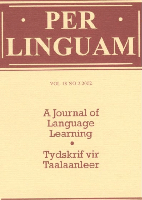
Per Linguam-A Journal of Language Learning
Fostering Dialogue in Language Acquisition and PedagogyPer Linguam - A Journal of Language Learning, published by the University of Stellenbosch's Department Didaktiek, is a distinguished open-access journal that has been a vital resource for language educators and researchers since 1985. With an ISSN of 0259-2312 and an E-ISSN of 2224-0012, it fosters scholarly dialogue surrounding language acquisition and pedagogy. Positioned in the Q4 category in Developmental and Educational Psychology and Education, and Q3 in Linguistics and Language for 2023, this journal addresses crucial aspects of language learning that impact both teaching practices and learner outcomes. Although its Scopus rankings reveal challenges, the journal remains committed to its objectives of advancing knowledge and innovation in language education. Operating from Matieland, South Africa, Per Linguam invites contributions that explore the intersections of theory, research, and practical application, offering a platform for educators, students, and policymakers to share insights and strategies that can transform language learning experiences globally.